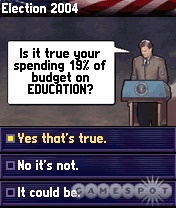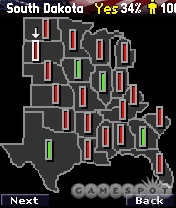There have been a number of different takes on America's upcoming presidential race, ranging from serious documentaries to thousand-page tomes to mobile boxing games, but very few thus far have looked at the absurdity of the electoral process itself. Lunagames's Election 2004, perhaps best described as SimPres, manages to be humorous and thoughtful. This tycoon-style game is far from perfect, but it's still one of the most original games for the mobile in a while.

In Election 2004, your goal is to use any means necessary to get enough state votes to be elected. There is only one other candidate (no Ralph Nader here), so it is a one-on-one battle that plays very much like Risk--that is, a fight over territory. The game takes place over 210 days, or 30 weeks, and each round lasts one week.
The game begins with naming your candidate, picking a party (Democrat or Republican), and choosing an avatar based on real presidents and candidates. The digital heads are surprisingly detailed, allowing you to play the realistic likeness of George Bush Jr. and Sr., John Kerry, Bill Clinton, Ronald Reagan or, if you like the classics, John F. Kennedy. It also adds to the game's mildly subversive context, as you can pick a George W. Bush icon and make liberal decisions, or do the opposite with John Kerry's character. The character selection is followed by two important decisions: home state and campaign platform. First you select your home state, where, according to the game, "you will have an extra charisma advantage," which proves useful during presidential debates.
Next, you pick the five most important campaign points from a list of 45. The choices are divided among nine broad topics: education, health, military, internal affairs, justice, economy, environment, agriculture, and foreign politics. Under each topic are five specific points. For instance, the education category lists the following talking points: more teachers; get ahead in research; bigger classes; more space research; and fewer special schools.
Finally, you must divide your proposed budget between the nine broad topics. The most that can be spent in one area is 19 percent of the budget. It's smart to write down the details of both the proposed budget and the five campaign points, as they will come up again throughout the campaign.
The basis of the campaign is the 50 states, represented on three game screens. Each state can either be blue, red, or gray. A blue state means you have 51 percent or more of the votes. Red means that your opponent has 51 percent or more of the votes. Gray means it is a dead heat.
Pointing to a specific state will make a ticker appear that shows the vote percentage in your favor, the amount of volunteers in the state, and the amount of ad dollars being spent there. The number of volunteers begins at 100, while advertising money starts off at zero. You can also drum up support by buying ad time at $10,000 a pop, hiring staff to increase state interest, or, most importantly, participating in a debate.
The debates are one of the quirkiest aspects of Election 2004. They are really more aggressive news conferences than speaking competitions, as the computer will grill you about your current campaign strategy. For instance, it may ask: "Is it true your [sic] spending 10% of budget on HEALTH?" From this you can answer "Yes, that's true," "No, it's not," or, if you want to be nebulous, say "It could be." Answering with a wrong answer can actually have you leave a debate with a two percent decrease in support. However, answering a handful of questions correctly can cause a serious surge in polls. You can only participate in one debate per round.
Random news alerts, given through a cool CNN-style screen, also give the opportunity to form public opinion. A report may say: "Libya sinks US frigate," at which time the game will give you the option of advocating "peace talks," suggesting that we "cover it up," or simply throwing internationalism to the wind and calling for war.
Aside from the debates and news briefs, the 30-weeklong campaign trail is an odd mix of fundraising, damage control, and good old dirt digging. Your campaign begins with $500,000, an ample amount of money at the beginning of the game, but hardly sufficient for long. After all, it costs up to $100,000 for a good state staff or a strong ad campaign, meaning that players will be panhandling by the campaign stretch. Fortunately, Monopoly-like random events will give you opportunities to make money. Some are benign charities, like supporters in Kansas raising $10,000 for your campaign. The big fish--which donate $25,000 and up--require a bit more finesse, since their objectives can lie in opposition to your campaign promises. For instance, an organization presumably related to the car industry may ask you to promise "No new regulations on CO2 exhaust" in exchange for the tidy sum of $250,000. This may go against one of your five campaign points, and if news of your backsliding gets out, it could drop voter response by up to 10 percent. At the same time, the amount of support that $250,000 can drum up may make the risk worthwhile. Decisions like these are the essence of Election 2004.
The most fun part of Election 2004 is using backstabbing tactics against your opponent. At the conclusion of every week, you'll have a choice between two covert operations: Digging for Dirt and Active Actions. Digging for Dirt is the less malicious of the two. You can spend up to $250,000 to hire a detective, who will mount an effort to drag skeletons out of your opponent's closet.
The more enjoyable option by far is Active Actions, which lists 13 different evil things that can be done to drop your opponent's support. These range from "Put false evidence in paper ($25,000)" to "Fake police record ($75,000)." One guaranteed to promote hilarity is "Send hooker and take pictures ($50,000)." Scandals break at random, and high-road gamers beware: The computer has no qualms about slinging as much mud as possible to win.

Election 2004 is a lot of fun, but it has several peccadilloes--namely, the difficulty level, the text speed, and the game length. The game shows no mercy for novices, so expect to lose many, many campaigns before locking down a presidency. Secondly, the user interface is great, but the text speed is painfully slow; an option to speed up things would have helped tremendously. Finally, a single game of Election 2004 takes a really long time. Each game is 30 rounds, each consisting of a survey of the 50 states, random news breaks and scandals, an optional debate, and a summary of the week's events. The game is interesting, but play begins to lose steam around week 15 or 20.
There is no sound, but it's not really missed in the game. The ending screen is a weak still shot of your avatar in the White House. The game truly embodies the axiom, "It's the journey, not the destination."
Election 2004 is a fun game for strategy fans and armchair politicians, as well as for those with a cynical view of the democratic process. The witty humor, evil plotting, and pop culture timeliness make this game a treat.